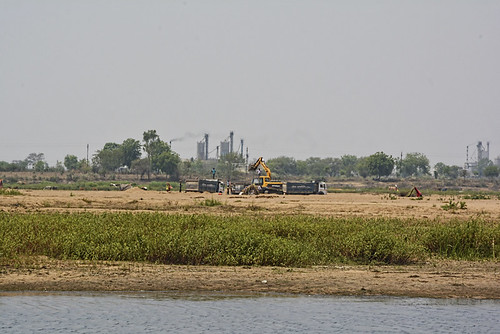By Sophia Lee
Have you ever heard the saying, “Get on the wrong side of the Mafia, and you’ll find yourself with cement overshoes, swimming with the fishes”? This grim adage is materializing throughout the world with our overuse of sand.
You may wonder: why sand? Sand drives the concrete industry, making it the most-used natural resource after water. Plus, the practice of sand mining suck(s) up almost a tenth of the world’s industrial water use, erodes beaches, muddies rivers, and destroys natural habitats. So pray tell, why can the biggest perpetrators of this practice—China and India—continue to mine unhindered? A large reason is the “Sand Mafia.”
I’m not joking. As environmental criminals, they’ve done it all. From pulverizing local officials with tractors or burning reporters alive, this “Sand Mafia” illegally and excessively mines and sells sand on black markets. Supplying around 40 billion tons of sand a year for an even greater demand is not only environmentally dangerous, but it also proves the widespread demand for urban development.
This threat not only stems from the destruction of natural resources, but largely from how cement production drives climate change through pollution and urbanization. According to The Guardian, if the cement industry were a country, it would be the third-largest carbon dioxide emitter in the world with up to 2.8bn tonnes (about 3.1bn US tons), surpassed only by China and the US.
I won’t deny that concrete’s a seriously useful material, and it’s hard to imagine a developing world without it. Nevertheless, the concrete industry, a necessary evil, must be reformed, and rehabilitation of the concrete industry starts with cement itself.
Cement alternatives, green—both literally and figuratively—can break us free from a devil’s choice of deciding between living in a developed world or living on our planet. For example, Solidia Industries—specializing in partial replacements (like graphene), recycled cement—and “Living Building Materials”. Disregarding the latter’s horror film-esque vibe, these LBMs “grow” on their own, as according to The New York Times, they largely consist of “cyanobacteria… that capture energy through photosynthesis. The photosynthetic process absorbs carbon dioxide.” Thus, LBM’s could possibly solve this concrete crisis while providing a sustainable cement alternative—making cement into a solution for climate change instead of a major culprit.
In the meantime, however, further research is necessary before this alternative can be accepted commercially, and this will require funding, skilled personnel, and most of all: advocacy. The importance of each and every voice, youth or adult, shouldn’t be underestimated—for while the act of just raising awareness alone won’t solve the problem, it’s definitely the first step towards finding a solution that doesn’t involve murder, cement, and terribly heavy carbon feet.

